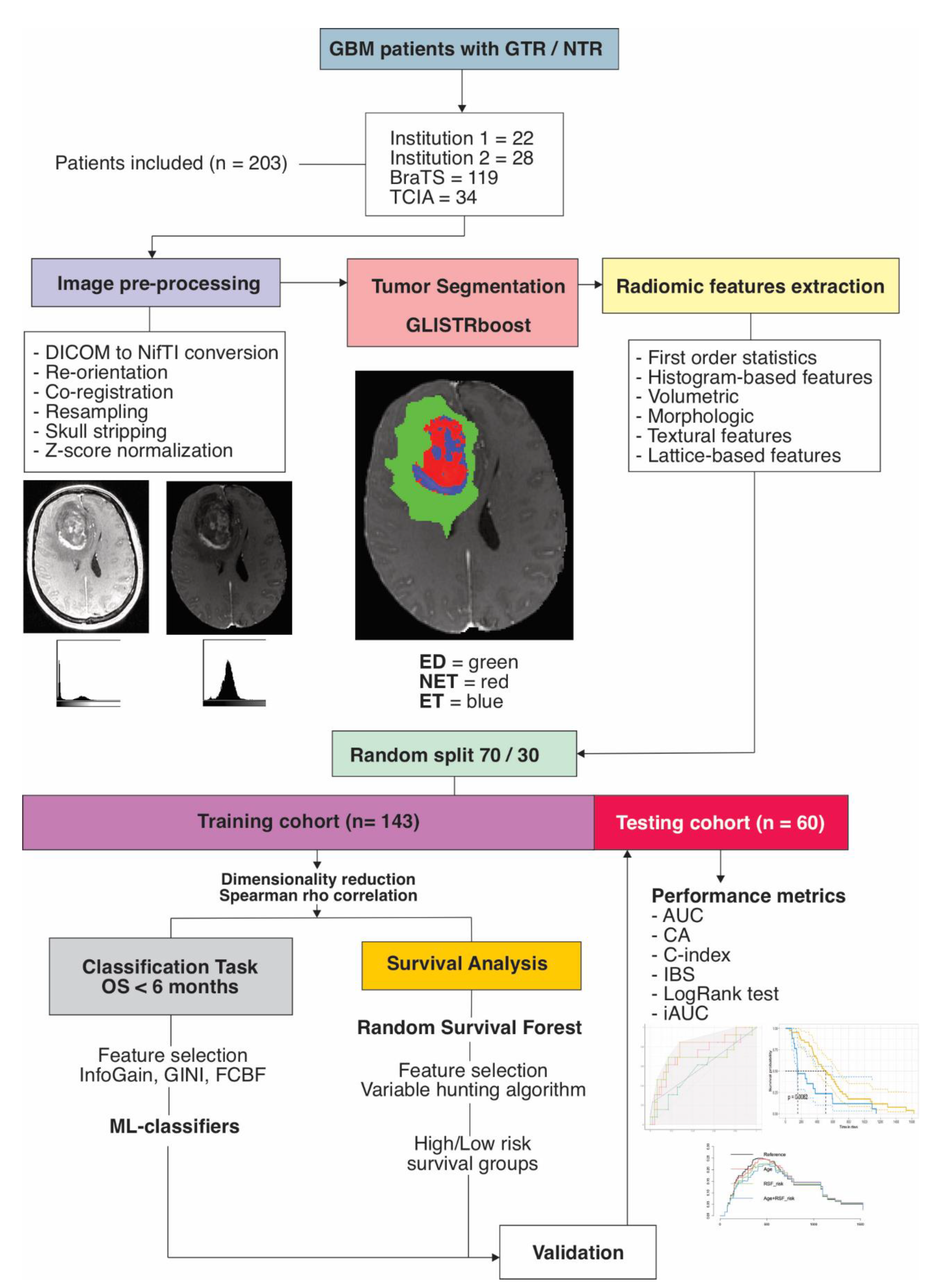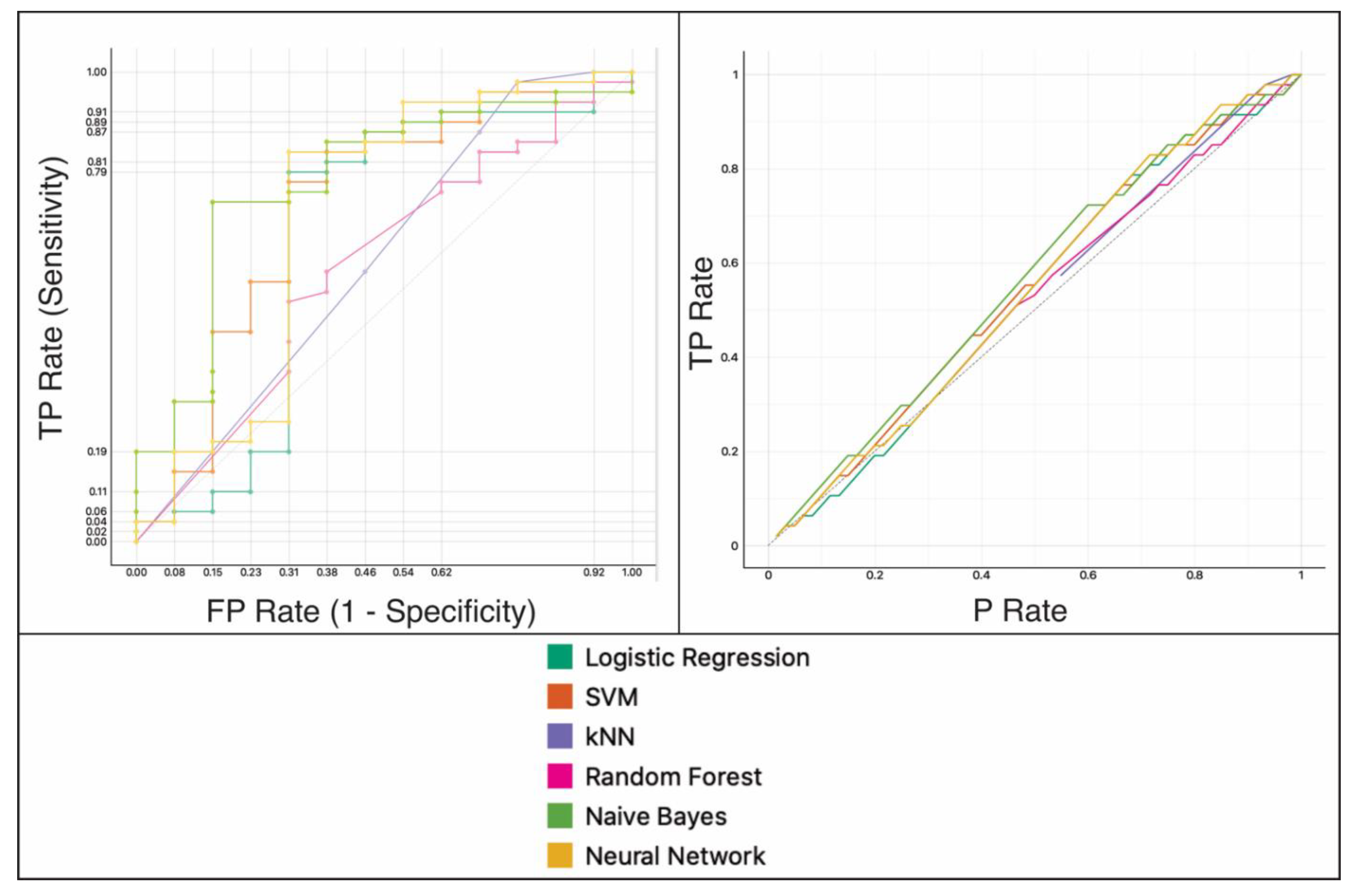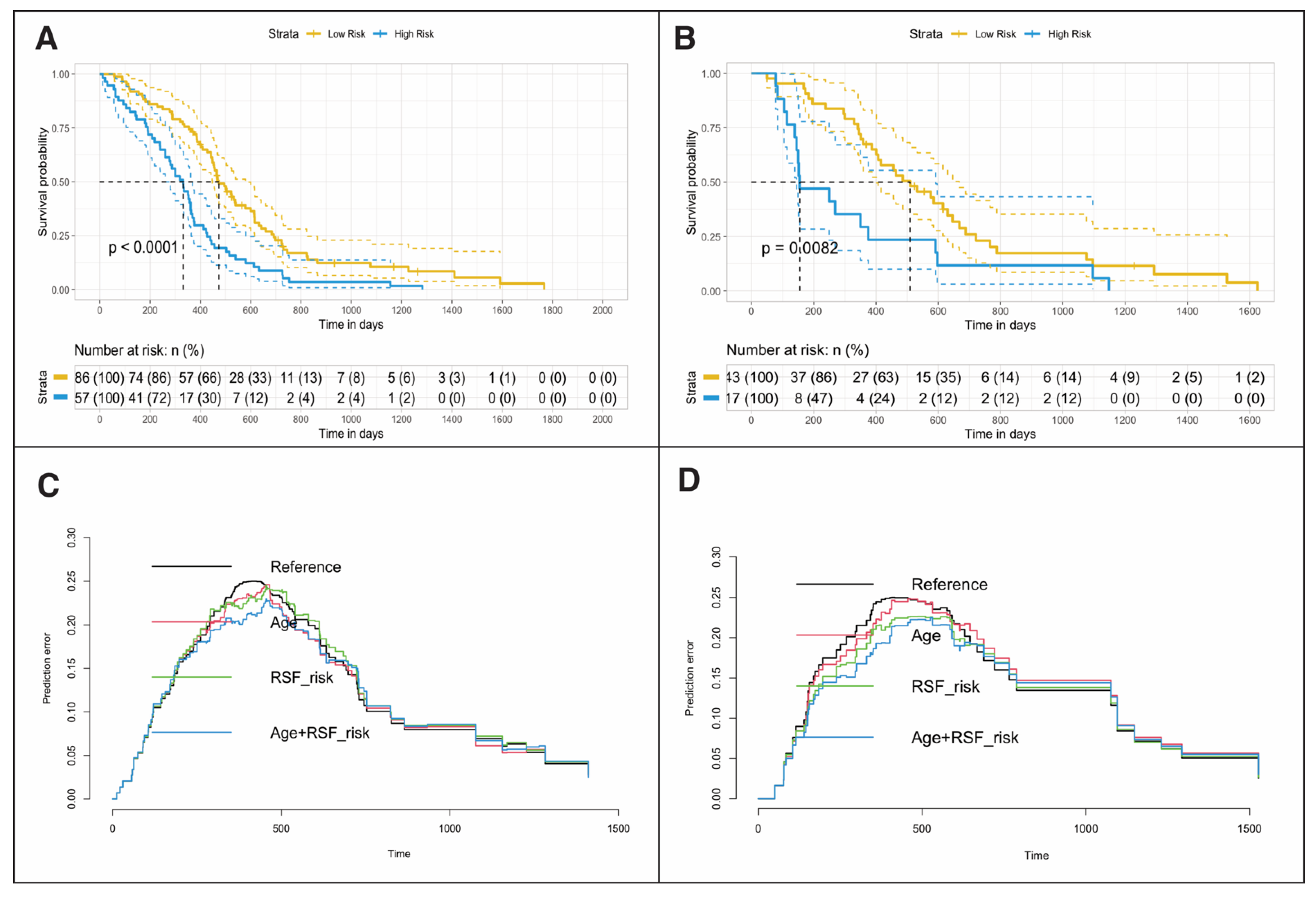Predicting Short-Term Survival after Gross Total or Near Total Resection in Glioblastomas by Machine Learning-Based Radiomic Analysis of Preoperative MRI
Abstract
:Simple Summary
Abstract
1. Introduction
2. Materials and Methods
2.1. Study Population
2.2. Image Data Description and Preprocessing
2.3. Tumor Segmentation and Feature Extraction
2.4. Data Processing and Feature Selection
2.5. Statistical Analysis and Machine Learning
3. Results
3.1. Patient Population
3.2. Classification Task and Survival Groups
3.3. Random Survival Forest to Predict OS
4. Discussion
5. Conclusions
Supplementary Materials
Author Contributions
Funding
Institutional Review Board Statement
Informed Consent Statement
Data Availability Statement
Conflicts of Interest
References
- Koshy, M.; Villano, J.L.; Dolecek, T.A.; Howard, A.; Mahmood, U.; Chmura, S.J.; Weichselbaum, R.R.; McCarthy, B.J. Improved survival time trends for glioblastoma using the SEER 17 population-based registries. J. Neurooncol. 2012, 107, 207–212. [Google Scholar] [CrossRef] [Green Version]
- Stupp, R.; Hegi, M.E.; Mason, W.P.; van den Bent, M.J.; Taphoorn, M.J.B.; Janzer, R.C.; Ludwin, S.K.; Allgeier, A.; Fisher, B.; Belanger, K.; et al. Effects of radiotherapy with concomitant and adjuvant temozolomide versus radiotherapy alone on survival in glioblastoma in a randomised phase III study: 5-year analysis of the EORTC-NCIC trial. Lancet. Oncol. 2009, 10, 459–466. [Google Scholar] [CrossRef]
- Sanai, N.; Berger, M.S. Surgical oncology for gliomas: The state of the art. Nat. Rev. Clin. Oncol. 2018, 15, 112–125. [Google Scholar] [CrossRef]
- Gutman, D.A.; Cooper, L.A.D.; Hwang, S.N.; Holder, C.A.; Gao, J.; Aurora, T.D.; Dunn, W.D.; Scarpace, L.; Mikkelsen, T.; Jain, R.; et al. MR Imaging predictors of molecular profile and survival: Multi-institutional Study of the TCGA Glioblastoma Data Set. Radiology 2013, 267, 560–569. [Google Scholar] [CrossRef]
- Chaddad, A.; Kucharczyk, M.J.; Daniel, P.; Sabri, S.; Jean-Claude, B.J.; Niazi, T.; Abdulkarim, B. Radiomics in glioblastoma: Current status and challenges facing clinical implementation. Front. Oncol. 2019, 9, 1–9. [Google Scholar] [CrossRef] [Green Version]
- Gillies, R.J.; Kinahan, P.E.; Hricak, H. Radiomics: Images Are more than pictures, they are data. Radiology 2016, 278, 563–577. [Google Scholar] [CrossRef] [Green Version]
- Seow, P.; Wong, J.H.D.; Ahmad-Annuar, A.; Mahajan, A.; Abdullah, N.A.; Ramli, N. Quantitative magnetic resonance imaging and radiogenomic biomarkers for glioma characterisation: A systematic review. Br. J. Radiol. 2018, 91, 20170930. [Google Scholar] [CrossRef]
- Osman, A.F.I. A multi-parametric MRI-Based radiomics signature and a practical ML Model for stratifying glioblastoma patients based on survival toward precision oncology. Front. Comput. Neurosci. 2019, 13, 58. [Google Scholar] [CrossRef] [Green Version]
- Kickingereder, P.; Burth, S.; Wick, A.; Götz, M.; Eidel, O.; Schlemmer, H.-P.; Maier-Hein, K.H.; Wick, W.; Bendszus, M.; Radbruch, A.; et al. Radiomic Profiling of glioblastoma: Identifying an Imaging predictor of patient survival with improved performance over established clinical and radiologic risk models. Radiology 2016, 280, 880–889. [Google Scholar] [CrossRef]
- Bae, S.; Choi, Y.S.; Ahn, S.S.; Chang, J.H.; Kang, S.-G.; Kim, E.H.; Kim, S.H.; Lee, S.-K. Radiomic MRI Phenotyping of glioblastoma: Improving survival prediction. Radiology 2018, 289, 797–806. [Google Scholar] [CrossRef]
- Shboul, Z.A.; Alam, M.; Vidyaratne, L.; Pei, L.; Elbakary, M.I.; Iftekharuddin, K.M. Feature-guided deep radiomics for glioblastoma patient survival prediction. Front. Neurosci. 2019, 13, 966. [Google Scholar] [CrossRef]
- Chaddad, A.; Daniel, P.; Sabri, S.; Desrosiers, C.; Abdulkarim, B. Integration of radiomic and multi-omic analyses predicts survival of newly diagnosed IDH1 wild-type glioblastoma. Cancers 2019, 11, 1148. [Google Scholar] [CrossRef] [Green Version]
- Baid, U.; Rane, S.U.; Talbar, S.; Gupta, S.; Thakur, M.H.; Moiyadi, A.; Mahajan, A. Overall survival prediction in glioblastoma with radiomic features using machine learning. Front. Comput. Neurosci. 2020, 14, 1–9. [Google Scholar] [CrossRef]
- Bakas, S.; Shukla, G.; Akbari, H.; Erus, G.; Sotiras, A.; Rathore, S.; Sako, C.; Min Ha, S.; Rozycki, M.; Shinohara, R.T.; et al. Overall survival prediction in glioblastoma patients using structural magnetic resonance imaging (MRI): Advanced radiomic features may compensate for lack of advanced MRI modalities. J. Med. Imaging 2020, 7, 031505. [Google Scholar] [CrossRef]
- Menze, B.H.; Jakab, A.; Bauer, S.; Kalpathy-Cramer, J.; Farahani, K.; Kirby, J.; Burren, Y.; Porz, N.; Slotboom, J.; Wiest, R.; et al. The Multimodal Brain Tumor Image Segmentation Benchmark (BRATS). IEEE Trans. Med. Imaging 2015, 34, 1993–2024. [Google Scholar] [CrossRef]
- Bakas, S.; Reyes, M.; Jakab, A.; Bauer, S.; Rempfler, M.; Crimi, A.; Shinohara, R.T.; Berger, C.; Ha, S.M.; Rozycki, M.; et al. Identifying the best machine learning algorithms for brain tumor segmentation, progression assessment, and overall survival prediction in the BRATS challenge. arXiv 2018, arXiv:1811.02629. [Google Scholar]
- Bakas, S.; Akbari, H.; Sotiras, A.; Bilello, M.; Rozycki, M.; Kirby, J.S.; Freymann, J.B.; Farahani, K.; Davatzikos, C. Advancing the cancer genome atlas glioma MRI collections with expert segmentation labels and radiomic features. Sci. Data 2017, 4, 170117. [Google Scholar] [CrossRef] [Green Version]
- Puchalski, R.B.; Shah, N.; Miller, J.; Dalley, R.; Nomura, S.R.; Yoon, J.-G.; Smith, K.A.; Lankerovich, M.; Bertagnolli, D.; Bickley, K.; et al. An anatomic transcriptional atlas of human glioblastoma. Science 2018, 360, 660–663. [Google Scholar] [CrossRef] [Green Version]
- Clark, K.; Vendt, B.; Smith, K.; Freymann, J.; Kirby, J.; Koppel, P.; Moore, S.; Phillips, S.; Maffitt, D.; Pringle, M.; et al. The Cancer Imaging Archive (TCIA): Maintaining and Operating a public information repository. J. Digit. Imaging 2013, 26, 1045–1057. [Google Scholar] [CrossRef] [Green Version]
- Rohlfing, T.; Zahr, N.M.; Sullivan, E.V.; Pfefferbaum, A. The SRI24 multichannel atlas of normal adult human brain structure. Hum. Brain Mapp. 2010, 31, 798–819. [Google Scholar] [CrossRef] [Green Version]
- Tustison, N.J.; Avants, B.B.; Cook, P.A.; Zheng, Y.; Egan, A.; Yushkevich, P.A.; Gee, J.C. N4ITK: Improved N3 bias correction. IEEE Trans. Med. Imaging 2010, 29, 1310–1320. [Google Scholar] [CrossRef] [Green Version]
- Thakur, S.; Doshi, J.; Pati, S.; Rathore, S.; Sako, C.; Bilello, M.; Ha, S.M.; Shukla, G.; Flanders, A.; Kotrotsou, A.; et al. Brain extraction on MRI scans in presence of diffuse glioma: Multi-institutional performance evaluation of deep learning methods and robust modality-agnostic training. Neuroimage 2020, 220, 117081. [Google Scholar] [CrossRef]
- Davatzikos, C.; Rathore, S.; Bakas, S.; Pati, S.; Bergman, M.; Kalarot, R.; Sridharan, P.; Gastounioti, A.; Jahani, N.; Cohen, E.; et al. Cancer imaging phenomics toolkit: Quantitative imaging analytics for precision diagnostics and predictive modeling of clinical outcome. J. Med. Imaging 2018, 5, 011018. [Google Scholar] [CrossRef]
- Bakas, S.; Zeng, K.; Sotiras, A.; Rathore, S.; Akbari, H.; Gaonkar, B.; Rozycki, M.; Pati, S.; Davatzikos, C. GLISTRboost: Combining multimodal MRI Segmentation, registration, and biophysical tumor growth modeling with gradient boosting machines for glioma segmentation. In Brainlesion: Glioma, Multiple Sclerosis, Stroke and Traumatic Brain Injuries; Springer: Cham, Switzerland, 2016; Volume 9556, pp. 144–155. [Google Scholar] [CrossRef] [Green Version]
- Zwanenburg, A.; Vallières, M.; Abdalah, M.A.; Aerts, H.J.W.L.; Andrearczyk, V.; Apte, A.; Ashrafinia, S.; Bakas, S.; Beukinga, R.J.; Boellaard, R.; et al. The Image biomarker standardization initiative: Standardized Quantitative radiomics for high-throughput image-based phenotyping. Radiology 2020, 295, 328–338. [Google Scholar] [CrossRef] [Green Version]
- Ishwaran, H.; Kogalur, U.B. Fast Unified Random Forests for Survival, Regression, and Classification (RF-SRC), R Package version 2.12.1; The R Foundation: Vienna, Austria, 2019; Volume 2. [Google Scholar]
- Dardis, C. survMisc: Miscellaneous Functions for Survival Data; R Package Version 0.5.5; The R Foundation: Vienna, Austria, 2016. [Google Scholar]
- Mogensen, U.B.; Ishwaran, H.; Gerds, T.A. Evaluating Random forests for survival analysis using prediction error curves. J. Stat. Softw. 2012, 50, 1–23. [Google Scholar] [CrossRef]
- Heagerty, P.J.; Zheng, Y. Survival model predictive accuracy and ROC curves. Biometrics 2005, 61, 92–105. [Google Scholar] [CrossRef] [Green Version]
- Kamarudin, A.N.; Cox, T.; Kolamunnage-Dona, R. Time-dependent ROC curve analysis in medical research: Current methods and applications. BMC Med. Res. Methodol. 2017, 17, 53. [Google Scholar] [CrossRef] [Green Version]
- Demšar, J.; Curk, T.; Erjavec, A.; Gorup, Č.; Hočevar, T.; Milutinovič, M.; Možina, M.; Polajnar, M.; Toplak, M.; Starič, A.; et al. Orange: Data mining toolbox in Python. J. Mach. Learn. Res. 2013, 14, 2349–2353. [Google Scholar]
- Lambin, P.; Leijenaar, R.T.H.; Deist, T.M.; Peerlings, J.; de Jong, E.E.C.; van Timmeren, J.; Sanduleanu, S.; Larue, R.T.H.M.; Even, A.J.G.; Jochems, A.; et al. Radiomics: The bridge between medical imaging and personalized medicine. Nat. Rev. Clin. Oncol. 2017, 14, 749–762. [Google Scholar] [CrossRef]
- Awad, A.-W.; Karsy, M.; Sanai, N.; Spetzler, R.; Zhang, Y.; Xu, Y.; Mahan, M.A. Impact of removed tumor volume and location on patient outcome in glioblastoma. J. Neurooncol. 2017, 135, 161–171. [Google Scholar] [CrossRef]
- Fathi Kazerooni, A.; Akbari, H.; Shukla, G.; Badve, C.; Rudie, J.D.; Sako, C.; Rathore, S.; Bakas, S.; Pati, S.; Singh, A.; et al. Cancer imaging phenomics via CaPTk: Multi-institutional prediction of progression-free survival and pattern of recurrence in glioblastoma. JCO Clin. Cancer Inform. 2020, 234–244. [Google Scholar] [CrossRef]
- Kickingereder, P.; Neuberger, U.; Bonekamp, D.; Piechotta, P.L.; Götz, M.; Wick, A.; Sill, M.; Kratz, A.; Shinohara, R.T.; Jones, D.T.W.; et al. Radiomic subtyping improves disease stratification beyond key molecular, clinical, and standard imaging characteristics in patients with glioblastoma. Neuro. Oncol. 2018, 20, 848–857. [Google Scholar] [CrossRef]
- Lu, Y.; Patel, M.; Natarajan, K.; Ughratdar, I.; Sanghera, P.; Jena, R.; Watts, C.; Sawlani, V. Machine learning-based radiomic, clinical and semantic feature analysis for predicting overall survival and MGMT promoter methylation status in patients with glioblastoma. Magn. Reson. Imaging 2020, 74, 161–170. [Google Scholar] [CrossRef]
- Kickingereder, P.; Götz, M.; Muschelli, J.; Wick, A.; Neuberger, U.; Shinohara, R.T.; Sill, M.; Nowosielski, M.; Schlemmer, H.P.; Radbruch, A.; et al. Large-scale radiomic profiling of recurrent glioblastoma identifies an imaging predictor for stratifying anti-angiogenic treatment response. Clin. Cancer Res. 2016, 22, 5765–5771. [Google Scholar] [CrossRef] [Green Version]
- Ingrisch, M.; Schneider, M.J.; Nörenberg, D.; Negrao de Figueiredo, G.; Maier-Hein, K.; Suchorska, B.; Schüller, U.; Albert, N.; Brückmann, H.; Reiser, M.; et al. Radiomic analysis reveals prognostic information in T1-weighted baseline magnetic resonance imaging in patients with glioblastoma. Invest. Radiol. 2017, 52, 360–366. [Google Scholar] [CrossRef]
- Liu, Y.; Xu, X.; Yin, L.; Zhang, X.; Li, L.; Lu, H. Relationship between Glioblastoma heterogeneity and survival time: An MR imaging texture analysis. AJNR. Am. J. Neuroradiol. 2017, 38, 1695–1701. [Google Scholar] [CrossRef] [Green Version]
- Prasanna, P.; Patel, J.; Partovi, S.; Madabhushi, A.; Tiwari, P. Radiomic features from the peritumoral brain parenchyma on treatment-naïve multi-parametric MR imaging predict long versus short-term survival in glioblastoma multiforme: Preliminary findings. Eur. Radiol. 2017, 27, 4188–4197. [Google Scholar] [CrossRef]
- Kim, J.Y.; Yoon, M.J.; Park, J.E.; Choi, E.J.; Lee, J.; Kim, H.S. Radiomics in peritumoral non-enhancing regions: Fractional anisotropy and cerebral blood volume improve prediction of local progression and overall survival in patients with glioblastoma. Neuroradiology 2019, 61, 1261–1272. [Google Scholar] [CrossRef]
- Rathore, S.; Bakas, S.; Pati, S.; Akbari, H.; Kalarot, R.; Sridharan, P.; Rozycki, M.; Bergman, M.; Tunc, B.; Verma, R.; et al. Brain cancer imaging phenomics toolkit (brain-CaPTk): An interactive platform for quantitative analysis of glioblastoma. In Brainlesion: Glioma, Multiple Sclerosis, Stroke and Traumatic Brain Injuries; Springer: Cham, Switzerland, 2018; Volume 10670 LNCS, pp. 133–145. [Google Scholar] [CrossRef]
- Davatzikos, C.; Barnholtz-Sloan, J.S.; Bakas, S.; Colen, R.; Mahajan, A.; Quintero, C.B.; Capellades Font, J.; Puig, J.; Jain, R.; Sloan, A.E.; et al. AI-based prognostic imaging biomarkers for precision neuro-oncology: The ReSPOND consortium. Neuro. Oncol. 2020, 22, 886–888. [Google Scholar] [CrossRef]



| Data Set | n | Age (SD) | Tumor Volume (cm3) | OS (IQR) | Censored (%) | OS < 6 m (%) |
|---|---|---|---|---|---|---|
| BraTS | 119 | 62 ± 12 | 30.09 ± 11.77 | 374 (364) | 0 | 21.8% (26) |
| TCIA | 34 | 60.3 ± 10 | 42.55 ± 15.71 | 414 (482) | 5.9% (2) | 17.6% (6) |
| Institution 1 | 22 | 65.3 ± 10 | 40.77 ± 18.12 | 451 (307) | 22.7% (5) | 13.6% (3) |
| Institution 2 | 28 | 57.9 ± 13 | 42.14 ± 17.16 | 466 (217) | 32.1% (9) | 0 |
| After random split (70/30) | ||||||
| Training | 143 | 62.1 ± 11 | 40.62 ± 10.27 | 409 (311) | 7.7% (11) | 17.5% (25) |
| Testing | 60 | 60.1 ± 13 | 39.27 ± 11.35 | 404 (392) | 8.3% (5) | 16.7% (10) |
| Statistical comparison between cohorts | t = 0.10, p = 0.273 | t = 0.12, p = 0.902 | U = 0.33, p = 0.743 | χ2 = 0.02, p = 0.877 | χ2 = 1.17, p = 0.279 | |
| Filter | ||
|---|---|---|
| Information Gain | Gini Index | FCBF |
| T1CE_ED_Lattice_Histogram_Bins-20_Radius-1_Bins-20_NinetyFifthPercentile_Skewness | T1CE_ET_Lattice_Histogram_Bins-20_Radius-1_Bins-20_Range_Max | T1CE_ED_Lattice_Histogram_Bins-20_Radius-1_Bins-20_NinetyFifthPercentile_Skewness |
| T1CE_ED_Lattice_Histogram_Bins-20_Radius-1_Bins-20_NinetyFifthPercentile_Kurtosis | T1CE_ED_Lattice_Histogram_Bins-20_Radius-1_Bins-20_NinetyFifthPercentile_Kurtosis | T2WI_ED_Lattice_Intensity_Bins-20_Radius-1_QuartileCoefficientOfVariation_StdDev |
| T1CE_ET_Lattice_Histogram_Bins-20_Radius-1_Bins-20_Range_Max | T1CE_ED_Lattice_Histogram_Bins-20_Radius-1_Bins-20_NinetyFifthPercentile_Skewness | T1CE_ET_Lattice_Histogram_Bins-20_Radius-1_Bins-20_Energy_Skewness |
| T2WI_ED_Lattice_Intensity_Bins-20_Radius-1_QuartileCoefficientOfVariation_StdDev | FLAIR_ET_Lattice_Morphologic_EquivalentSphericalRadius_Variance | T1CE_ED_Lattice_Histogram_Bins-20_Radius-1_Bins-20_NinetyFifthPercentile_Kurtosis |
| FLAIR_ET_Lattice_Morphologic_EquivalentSphericalPerimeter_Variance | FLAIR_ET_Lattice_Morphologic_EquivalentSphericalPerimeter_Variance | T1CE_ET_Lattice_Histogram_Bins-20_Radius-1_Bins-20_Range_Max |
| FLAIR_ET_Lattice_Morphologic_EquivalentSphericalRadius_Variance | FLAIR_NET_Lattice_Histogram_Bins-20_Bins-20_Bin-12_Frequency_Median | FLAIR_ET_Lattice_Morphologic_EquivalentSphericalPerimeter_Variance |
| FLAIR_NET_Lattice_Histogram_Bins-20_Radius-1_Bins-20_InterQuartileRange_StdDev | T2WI_ED_Lattice_Intensity_Bins-20_Radius-1_Mean_Skewness | FLAIR_ET_Lattice_Morphologic_EquivalentSphericalRadius_Variance |
| FLAIR_NET_Lattice_Histogram_Bins-20_Radius-1_Bins-20_InterQuartileRange_Variance | T2WI_ED_Lattice_Intensity_Bins-20_Radius-1_QuartileCoefficientOfVariation_StdDev | FLAIR_NET_Lattice_Histogram_Bins-20_Radius-1_Bins-20_InterQuartileRange_StdDev |
| FLAIR_NET_Lattice_Histogram_Bins-20_Bins-20_Uniformity_Min | FLAIR_NET_Lattice_Histogram_Bins-20_Bins-20_Uniformity_Min | FLAIR_NET_Lattice_Histogram_Bins-20_Bins-20_Bin-12_Frequency_Median |
| A10824 FLAIR_NET_Lattice_Histogram_Bins-20_Bins-20_Bin-12_Frequency_Median | FLAIR_NET_Lattice_Histogram_Bins-20_Radius-1_Bins-20_InterQuartileRange_Variance | FLAIR_NET_Lattice_Histogram_Bins-20_Radius-1_Bins-20_InterQuartileRange_Variance |
| Classifier | Filter | AUC | CA | Precision | F1 |
|---|---|---|---|---|---|
| Naive Bayes | Information Gain | 0.769 | 0.800 | 0.812 | 0.805 |
| Gini Index | 0.784 | 0.767 | 0.810 | 0.781 | |
| FCBF | 0.743 | 0.783 | 0.803 | 0.791 | |
| k-Nearest Neighbor | Information Gain | 0.600 | 0.817 | 0.806 | 0.776 |
| Gini Index | 0.639 | 0.800 | 0.771 | 0.763 | |
| FCBF | 0.670 | 0.767 | 0.713 | 0.724 | |
| Neural Network | Information Gain | 0.691 | 0.800 | 0.771 | 0.763 |
| Gini Index | 0.682 | 0.767 | 0.691 | 0.705 | |
| FCBF | 0.722 | 0.817 | 0.806 | 0.776 | |
| Random Forest | Information Gain | 0.574 | 0.733 | 0.683 | 0.701 |
| Gini Index | 0.666 | 0.750 | 0.696 | 0.713 | |
| FCBF | 0.700 | 0.783 | 0.738 | 0.735 | |
| Support Vector Machine | Information Gain | 0.709 | 0.750 | 0.608 | 0.671 |
| Gini Index | 0.630 | 0.750 | 0.608 | 0.671 | |
| FCBF | 0.730 | 0.800 | 0.777 | 0.747 | |
| Logistic Regression | Information Gain | 0.648 | 0.783 | 0.614 | 0.688 |
| Gini Index | 0.643 | 0.783 | 0.614 | 0.688 | |
| FCBF | 0.656 | 0.783 | 0.614 | 0.688 |
| Nº | Feature |
|---|---|
| 1 | T1CE_NET_Lattice_GLSZM_Bins-20_Radius-1_LargeZoneHighGreyLevelEmphasis_Mean |
| 2 | FLAIR_ED_Lattice_NGTDM_Busyness_Max |
| 3 | T1CE_NET_Lattice_GLSZM_Bins-20_Radius-1_LargeZoneHighGreyLevelEmphasis_Median |
| 4 | FLAIR_NET_Lattice_Histogram_Bins-20_Radius-1_Bins-20_Bin-14_Frequency_Max |
| 5 | FLAIR_NET_Lattice_Intensity_Bins-20_Radius-1_NinetiethPercentile_Mean |
| 6 | T1CE_ET_Lattice_Intensity_Bins-20_Radius-1_StandardDeviation_StdDev |
| 7 | FLAIR_NET_Lattice_Morphologic_PixelsOnBorder_Variance |
| 8 | T1CE_ET_Lattice_Histogram_Bins-20_Radius-1_Bins-20_Bin-0_Probability_Kurtosis |
| 9 | T1CE_ET_Lattice_Histogram_Bins-20_Radius-1_Bins-20_Bin-9_Probability_Median |
| 10 | T1CE_ET_Lattice_GLSZM_Bins-20_Radius-1_ZoneSizeMean_Variance |
| 11 | T2WI_ED_Lattice_Intensity_Bins-20_Radius-1_Mean_Skewness |
| 12 | FLAIR_ET_Lattice_Morphologic_Perimeter_Skewness |
| 13 | FLAIR_NET_Lattice_Histogram_Bins-20_Radius-1_Bins-20_FifthPercentileMean_Max |
| 14 | FLAIR_ET_Lattice_Morphologic_EquivalentSphericalRadius_Variance |
| 15 | T1CE_ET_Lattice_GLRLM_Bins-20_Radius-1_RunLengthNonuniformity_Kurtosis |
| 16 | FLAIR_ED_Lattice_Intensity_Bins-20_Radius-1_InterQuartileRange_Median |
| 17 | FLAIR_ED_Lattice_Histogram_Bins-20_Radius-1_Bins-20_Sum_Max |
| Univariate Cox Regression Analysis | ||||||||
|---|---|---|---|---|---|---|---|---|
| Variable | β | HR | 95% CI | p | C-Index | IBS | iAUC | 6m-iAUC |
| Training data set | ||||||||
| Age | 0.03 | 1.03 | 1.02–1.05 | <0.001 | 0.61 | 0.089 | 0.604 | 0.599 |
| Radiomic RSF Score (High risk) | 0.78 | 2.19 | 1.54–3.12 | <0.001 | 0.61 | 0.096 | 0.591 | 0.712 |
| Testing data set | ||||||||
| Age | 0.03 | 1.03 | 1–1.06 | 0.023 | 0.60 | 0.128 | 0.592 | 0.643 |
| Radiomic RSF Score (High risk) | 0.77 | 2.16 | 1.21–3.89 | 0.009 | 0.61 | 0.123 | 0.568 | 0.761 |
| Multivariate Cox Regression Model | ||||||||
| Model | Likelihood Ratio Test | C-Index | IBS | iAUC | 6m-AUC | |||
| χ2 | df | p | ||||||
| Training data set | ||||||||
| Age + Radiomic RSF Score (High risk) | 36.93 | 2 | <0.001 | 0.66 | 0.084 | 0.650 | 0.730 | |
| Testing data set | ||||||||
| Age + Radiomic RSF Score (High risk) | 11.35 | 2 | 0.003 | 0.68 | 0.118 | 0.6278 | 0.769 | |
Publisher’s Note: MDPI stays neutral with regard to jurisdictional claims in published maps and institutional affiliations. |
© 2021 by the authors. Licensee MDPI, Basel, Switzerland. This article is an open access article distributed under the terms and conditions of the Creative Commons Attribution (CC BY) license (https://creativecommons.org/licenses/by/4.0/).
Share and Cite
Cepeda, S.; Pérez-Nuñez, A.; García-García, S.; García-Pérez, D.; Arrese, I.; Jiménez-Roldán, L.; García-Galindo, M.; González, P.; Velasco-Casares, M.; Zamora, T.; et al. Predicting Short-Term Survival after Gross Total or Near Total Resection in Glioblastomas by Machine Learning-Based Radiomic Analysis of Preoperative MRI. Cancers 2021, 13, 5047. https://doi.org/10.3390/cancers13205047
Cepeda S, Pérez-Nuñez A, García-García S, García-Pérez D, Arrese I, Jiménez-Roldán L, García-Galindo M, González P, Velasco-Casares M, Zamora T, et al. Predicting Short-Term Survival after Gross Total or Near Total Resection in Glioblastomas by Machine Learning-Based Radiomic Analysis of Preoperative MRI. Cancers. 2021; 13(20):5047. https://doi.org/10.3390/cancers13205047
Chicago/Turabian StyleCepeda, Santiago, Angel Pérez-Nuñez, Sergio García-García, Daniel García-Pérez, Ignacio Arrese, Luis Jiménez-Roldán, Manuel García-Galindo, Pedro González, María Velasco-Casares, Tomas Zamora, and et al. 2021. "Predicting Short-Term Survival after Gross Total or Near Total Resection in Glioblastomas by Machine Learning-Based Radiomic Analysis of Preoperative MRI" Cancers 13, no. 20: 5047. https://doi.org/10.3390/cancers13205047
APA StyleCepeda, S., Pérez-Nuñez, A., García-García, S., García-Pérez, D., Arrese, I., Jiménez-Roldán, L., García-Galindo, M., González, P., Velasco-Casares, M., Zamora, T., & Sarabia, R. (2021). Predicting Short-Term Survival after Gross Total or Near Total Resection in Glioblastomas by Machine Learning-Based Radiomic Analysis of Preoperative MRI. Cancers, 13(20), 5047. https://doi.org/10.3390/cancers13205047







